Gallery
Photos from events, contest for the best costume, videos from master classes.
 |  |
 |  |
 |  |
 |  |
 |  |
 |  |
Nonetheless, St. Patrick's Day was co-opted by Protestants, who opted to don their representative orange instead of green for the day. The white stripe separating the green and orange ones on the country's flag is indicative of the unity both religions maintain, meaning there's no bad blood no matter what color you don. While the vast majority of people wear green on St. Patrick’s Day, some may wear orange to symbolise Protestant heritage or solidarity with Northern Ireland. However, if you’d like to know why some people wear orange on St. Patrick’s Day in Ireland and elsewhere, you’ll find all you need to know below. Wearing orange on St Patrick’s Day To understand why some people wear orange, you first have to understand why people wear green. St. Patrick's Day is a Roman Catholic holiday that was first celebrated in Ireland starting in 1631. Therefore, on St. Patrick’s Day, Protestants protest by wearing orange instead of green. Ironically, no one wears white; the placement of the white stripe between the green and orange stripes on the Irish flag is supposed to symbolize the peace between the Roman Catholic majority and the Protestant minority. Why Do Some People Wear Orange—Not Green—On St. Patrick’s Day? You might be used to people wearing green on St. Patrick’s Day, but some sport orange instead. Here’s why. St. Patrick’s Day is filled with rich St. Patrick’s Day usually conjures images of partying, Catholicism, Irish nationalism and, perhaps most famously, the color green: green clothes, green shamrocks, green beer and green rivers. Why is orange associated with St. Patrick’s Day? The color orange is associated with the Irish Protestant community and represents the country’s cultural diversity. It is a nod to the country’s rich cultural heritage and traditions. What is the significance of white in St. Patrick’s Day celebrations? To understand why some people wear orange, you first have to understand why people wear green. St. Patrick's Day is a Roman Catholic holiday that was first celebrated in Ireland starting in 1631. While most St. Patrick’s Day enthusiasts bust out their green clothing on March 17, there are some who would rather wear orange. The reason has everything to do with religion. SHREVEPORT, La -- March 17 marks Saint Patrick’s Day, Orange Irish: Why some prefer orange to green on St. Patrick's Day. Mar 16, 2021 Mar 16, 2021 Updated Aug 22, 2023; Why Is It Bad To Wear Orange on St Patrick’s Day? It's considered bad to wear orange on St. Patrick's Day because the color orange is associated with the Protestant community in Ireland, particularly with the Orange Order, which commemorates the victory of Protestant King William of Orange over the Catholic King James II in the Battle of the Boyne in 1690. St. Patrick’s Day, a cultural and religious celebration held on the 17th of March, is a day that commemorates Saint Patrick, the patron saint of Ireland. Traditionally, people celebrate this day by wearing green attire or accessories, attending parades, eating Irish food and drink, and generally participating in activities to honor Irish Incorporating orange and green into St. Patrick’s Day outfits can be a creative way to celebrate and acknowledge Ireland’s diverse heritage. History of Wearing Orange on St Patrick’s Day. Wearing orange on St. Patrick’s Day has its roots in Irish history, specifically, the events surrounding the Battle of the Boyne in 1690. The Irish government didn’t recognize St. Patrick’s Day as a public holiday until 1903, and the first parade in Dublin wasn’t held until 1931. Even pubs remained closed on March 17 until 1961. Every year, as March 17th rolls around, we’re smothered beneath an avalanche of green—green beer, green shamrocks, green everything—as if someone accidentally detonated a giant Leprechaun-themed confetti bomb. Amid this nauseating sea of verdant monotony, a dissenting few choose to wear orange, not as an alternative color choice, but as a rebuke to the cloying [] In conclusion, the question of why orange is offensive on St. Patrick’s Day unravels a tapestry woven with historical threads, political complexities, and contemporary sensitivities. While the color orange carries deep historical significance, the evolving nature of St. Patrick’s Day allows for a spectrum of perspectives and celebrations. While Catholics were associated with the color green, Protestants were associated with the color orange due to William of Orange – the Protestant king of England, Scotland and Ireland who in 1690 defeated the deposed Roman Catholic King James II. Why do people wear orange on St Pats day? The color orange represents the sizable Read More »Why Do Scottish Wear Orange On St Patrick Day? The Ultimate Guide to St. Patrick’s Day Colors: What Not to Wear. So, you’re prepping for St. Patrick’s Day and want to avoid a fashion faux pas (or worse, a pinch from a mischievous leprechaun!). The answer, according to tradition and a touch of historical context, is: you should probably avoid wearing orange on St. Patrick’s Day Some members of the order wore orange in various parades on Saint Patrick’s Day as a mark of defiance. Ironically, Saint Patrick himself would have been surprised by all of the fuss. While most St. Patrick’s Day enthusiasts bust out their green clothing on March 17, there are some who would rather wear orange. The reason has everything to do with religion.
Articles and news, personal stories, interviews with experts.
Photos from events, contest for the best costume, videos from master classes.
 |  |
 |  |
 |  |
 |  |
 |  |
 |  |